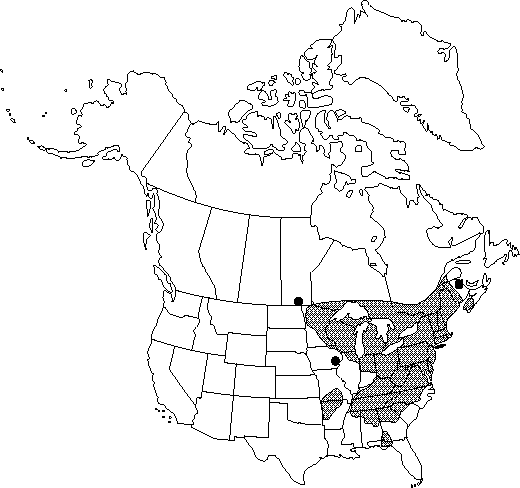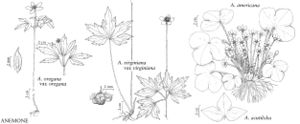Difference between revisions of "Anemone americana"
J. Jap. Bot. 33: 271. 1958.
FNA>Volume Importer |
FNA>Volume Importer |
Revision as of 22:15, 16 December 2019
Aerial shoots 5-18 cm, from rhizomes, rhizomes ascending to horizontal. Basal leaves 3-15, often purplish abaxially, simple, deeply divided; petiole 5-20 cm; leaf blade widely orbiculate, 1.5-7 × 2-10 cm, base cordate, margins entire, apex rounded, surfaces strongly villous to glabrescent; lobes 3(-4), widely ovate, 1-4 cm wide; middle lobe 50-70(-75)% of total blade length. Inflorescences 1-flowered, villous to pilose; involucral bracts 3, 1-tiered, simple, dissimilar to basal leaves, sessile, calyx-like, closely subtending flower, ovate or elliptic, 0.65-1.8 × 0.5-1.2 cm, bases distinct, cuneate, margins entire, apex obtuse, strongly villous to glabrescent. Flowers: sepals 5-12, white to pink or bluish, ovate to obovate 7.5-14.5 × 3.5-7.7 mm, glabrous; petals absent; stamens 10-30. Heads of achenes spheric; pedicel 0.1-0.4 cm. Achenes: body narrowly ovoid, 3.5-5 × 1.2-1.6 mm, slightly winged, hispid, gradually tapering; beak indistinct. 2n=14.
Phenology: Flowering spring.
Habitat: Mixed woods, often in association with both conifers and deciduous trees
Elevation: 0-1200 m
Distribution

Man., N.B., N.S., Ont., Que., Ala., Ark., Conn., Del., D.C., Fla., Ga., Ill., Ind., Iowa, Ky., Maine, Md., Mass., Mich., Minn., Miss., Mo., N.H., N.J., N.Y., N.C., Ohio, Pa., R.I., S.C., Tenn., Vt., Va., W.Va., Wis.
Discussion
Anemone americana is found in habitats similar to those of A. acutiloba but usually in drier sites with more acid soils.
Selected References
None.
